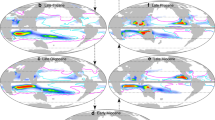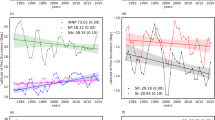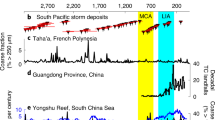Abstract
Recent research indicates that the annual-mean locations of tropical cyclones have migrated toward higher latitudes. Concurrently, an anthropogenically forced tropical expansion has been observed, yet the connection between the two processes remains little-explored. Here, using observational and reanalysis data, we investigate how large-scale dynamical effects, combined with coherent changes in the regional Hadley circulation, explain recent changes in regional tropical cyclone genesis over 1980–2014. We show that the recent anomalous upper-level weakening of the rising branch of the Hadley circulation in the deep tropics, possibly induced by the increased vertical stability, has likely suppressed the low-latitude tropical cyclone genesis in most ocean basins via anomalous large-scale subsidence. Regional Hadley circulation variations have also favoured a poleward displacement of tropical-cyclone-favourable climate conditions through poleward shift of the Hadley circulation’s meridional extent. With projections indicating continued tropical expansion, these results indicate that tropical cyclone genesis will also continue to shift poleward, potentially increasing tropical-cyclone-related hazards in higher-latitude regions.
This is a preview of subscription content, access via your institution
Access options
Access Nature and 54 other Nature Portfolio journals
Get Nature+, our best-value online-access subscription
$29.99 / 30 days
cancel any time
Subscribe to this journal
Receive 12 print issues and online access
$209.00 per year
only $17.42 per issue
Buy this article
- Purchase on Springer Link
- Instant access to full article PDF
Prices may be subject to local taxes which are calculated during checkout





Similar content being viewed by others
References
Peduzzi, P. et al. Global trends in tropical cyclone risk. Nat. Clim. Change 2, 289–294 (2012).
Gray, W. in Meteorology Over Tropical Oceans (ed. Shaw, D. B.) 155–218 (Royal Meteorological Society, Bracknell, 1979).
Sharmila, S. & Walsh, K. Impact of large-scale dynamical versus thermodynamical climate conditions on contrasting tropical cyclone genesis frequency. J. Clim. 30, 8865–8883 (2017).
Defforge, C. & Merlis, T. Observed warming trend in sea surface temperature at tropical cyclone genesis. Geophys. Res. Lett. 44, 1034–1040 (2017).
Dare, R. & McBride, J. The threshold sea surface temperature condition for tropical cyclogenesis. J. Clim. 24, 4570–4576 (2011).
Knutson, T. et al. Tropical cyclones andclimate change. Nat. Geosci. 3, 157–163 (2010).
Emanuel, K. Increasing destructiveness of tropical cyclones over the past 30 years. Nature 436, 686–688 (2005).
Webster, P. Changes in tropical cyclone number, duration, and intensity in a warming environment. Science 309, 1844–1846 (2005).
Grossmann, I. & Morgan, M. Tropical cyclones, climate change, and scientific uncertainty: what do we know, what does it mean, and what should be done? Climatic Change 108, 543–579 (2011).
Walsh, K. et al. Tropical cyclones and climate change. WIREs Clim. Change 7, 65–89 (2015).
Kossin, J., Emanuel, K. & Vecchi, G. The poleward migration of the location of tropical cyclone maximum intensity. Nature 509, 349–352 (2014).
Kossin, J., Emanuel, K. & Camargo, S. Past and projected changes in western North Pacific tropical cyclone exposure. J. Clim. 29, 5725–5739 (2016).
Li, T. et al. Global warming shifts Pacific tropical cyclone location. Geophys. Res. Lett. 37, L21804 (2010).
Murakami, H. et al. Future changes in tropical cyclone activity projected by the new high-resolution MRI-AGCM*. J. Clim. 25, 3237–3260 (2012).
Walsh, K. E. et al. Hurricanes and climate: the U.S. CLIVAR working group on hurricanes. Bull. Am. Meteorol. Soc. 96, 997–1017 (2015).
Song, J.-J. & Klotzbach, P. What has controlled the poleward migration of annual averaged location of tropical cyclone lifetime maximum intensity over the western North Pacific since 1961? Geophys. Res. Lett. 45, 1148–1156 (2018).
Liang, A., Oey, L., Huang, S. & Chou, S. Long-term trends of typhoon-induced rainfall over Taiwan: In situ evidence of poleward shift of typhoons in western North Pacific in recent decades. J. Geophys. Res. 122, 2750–2765 (2017).
Zhan, R. & Wang, Y. Weak tropical cyclones dominate the poleward migration of the annual mean location of lifetime maximum intensity of Northwest Pacific tropical cyclones since 1980. J. Clim. 30, 6873–6882 (2016).
Moon, I.-J., Kim, S.-H., Klotzbach, P. & Chan, J. C. L. Roles of interbasin frequency changes in the poleward shifts of the maximum intensity location of tropical cyclones. Environ. Res. Lett. 10, 104004 (2015).
Daloz, A. S. & Camargo, S. J. Is the poleward migration of tropical cyclone maximum intensity associated with a poleward migration of tropical cyclone genesis? Clim. Dynam. 50, 705–715 (2018).
Emanuel, K. Tropical cyclone activity downscaled from NOAACIRES reanalysis. J. Adv. Model. Earth Syst. 2, 1908–1958 (2010).
Camargo, S. J., Tippett, M. K., Sobel, A. H., Vecchi, G. A. & Zhao, M. Testing the performance of tropical cyclone genesis indices in future climates using the HIRAM model. J. Clim. 27, 9171–9196 (2014).
Lucas, C., Timbal, B. & Nguyen, H. The expanding tropics: a critical assessment of the observational and modeling studies. WIREs. Clim. Change 5, 89–112 (2014).
Hu, Y. & Fu, Q. Observed poleward expansion of the Hadley circulation since 1979. Atmos. Chem. Phys. 7, 5229–5236 (2007).
Polvani, L. M., Waugh, D. W., Correa, G. J. P. & Son, S.-W. Stratospheric ozone depletion: the main driver of twentieth-century atmospheric circulation changes in the Southern Hemisphere. J. Clim. 24, 795–812 (2011).
Quan, X.-W. et al. How fast are the tropics expanding? J. Clim. 27, 1999–2013 (2014).
Lu, J., Vecchi, G. A. & Reichler, T. Expansion of the Hadley cell under global warming. Geophys. Res. Lett. 34, L06805 (2007).
Vecchi, G. A. & Soden, B. J. Global warming and the weakening of the tropical circulation. J. Clim. 20, 4316–4340 (2007).
Gastineau, G., Le Treut, H. & Li, L. Hadley circulation changes under global warming conditions indicated by coupled climate models. Tellus 60A, 863–884 (2008).
Allen, R. J. & Kovilakam, M. The role of natural climate variability in recent tropical expansion. J. Clim. 30, 6329–6350 (2017).
Studholme, J. & Gulev, S. Concurrent changes to Hadley circulation and the meridional distribution of tropical cyclones. J. Clim. 31, 4367–4389 (2018).
Huang, B. et al. Extended Reconstructed Sea Surface Temperature version 4 (ERSST.v4). Part I: upgrades and intercomparisons. J. Clim. 28, 911–930 (2014).
Santer, B. D. et al. Tropospheric warming over the past two decades. Sci. Rep. 7, 2336 (2017).
Xiang, B., Wang, B., Lauer, A., Lee, J.-Y. & Ding, Q. Upper tropospheric warming intensifies sea surface warming. Clim. Dynam. 43, 259–270 (2014).
Knapp, K. R., Kruk, M. C., Levinson, D. H., Diamond, H. J. & Neumann, C. J. The International Best Track Archive for Climate Stewardship (IBTrACS) unifying tropical cyclone data. Bull. Am. Meteorol. Soc. 91, 363–376 (2010).
Dee, D. P. et al. The ERA-Interim reanalysis: configuration and performance of the data assimilation system. Q. J. R. Meteorol. Soc. 137, 553–597 (2011).
Mbengue, C. & Schneider, T. Storm track shifts under climate change: what can be learned from large-scale dry dynamics. J. Clim. 26, 9923–9930 (2013).
Taylor, K. E., Stouer, R. J. & Meehl, G. A. An overview of CMIP5 and the experimental design. Bull. Am. Meteorol. Soc. 93, 485498 (2012).
Hu, Y., Tao, L. & Liu, J. Poleward expansion of the Hadley circulation in CMIP5 simulations. Adv. Atmos. Sci. 30, 790–795 (2013).
Seo, K.-H., Frierson, D. M. W. & Son, J.-H. A mechanism for future changes in Hadley circulation strength in CMIP5 climate change simulations. Geophys. Res. Lett. 40, 5251–5258 (2014).
Schwendike, J. et al. Trends in the local Hadley and local Walker circulations. J. Geophys. Res. Atmos. 120, 7599–7618 (2015).
Nguyen, H. et al. Variability of the extent of the Hadley circulation in the Southern Hemisphere: a regional perspective. Clim. Dynam. 50, 129–142 (2018).
Neelin, J. D. & Held, I. M. Modeling tropical convergence based on the moist static energy budget. Mon. Weather Rev. 115, 3–12 (1987).
Emanuel, K. The maximum intensity of hurricanes. J. Atmos. Sci. 45, 1143–1155 (1988).
Emanuel, K. & Nolan, D. S. Tropical cyclone activity and the global climate system. In 26th Conf. on Hurricanes and Tropical Meteorology 240–241 (AMS, 2004).
Acknowledgements
This research was funded through the Australian Research Council Discovery Project (DP150102272) and partially through the Earth System and Climate Change Hub of the Australian government’s National Environmental Science Programme. The authors thank J. P. Kossin for his critical comments and valuable suggestions that improved the quality of the paper. S.S. acknowledges K. Emanuel (Massachusetts Institute of Technology), S. Camargo (Columbia University) and H. Hendon (Bureau of Meteorology) for valuable discussions. The assistance of resources from the National Computational Infrastructure supported by the Australian Government and the World Climate Research Programme’s Working Group on Coupled Modelling for available model output are duly acknowledged.
Author contributions
S.S. conceived the study and performed the analysis in discussion with K.J.E.W. Both the authors discussed the results and jointly contributed to writing the manuscript.
Author information
Authors and Affiliations
Corresponding author
Ethics declarations
Competing interests
The authors declare no competing interests.
Additional information
Publisher’s note: Springer Nature remains neutral with regard to jurisdictional claims in published maps and institutional affiliations.
Supplementary information
Supplementary Information
Supplementary table 1, Supplementary figures 1-8
Rights and permissions
About this article
Cite this article
Sharmila, S., Walsh, K.J.E. Recent poleward shift of tropical cyclone formation linked to Hadley cell expansion. Nature Clim Change 8, 730–736 (2018). https://doi.org/10.1038/s41558-018-0227-5
Received:
Accepted:
Published:
Issue Date:
DOI: https://doi.org/10.1038/s41558-018-0227-5
This article is cited by
-
Hemispheric asymmetric response of tropical cyclones to CO2 emission reduction
npj Climate and Atmospheric Science (2024)
-
Western North Pacific tropical cyclone activity modulated by phytoplankton feedback under global warming
Nature Climate Change (2024)
-
Large-scale photovoltaic solar farms in the Sahara affect solar power generation potential globally
Communications Earth & Environment (2024)
-
Climate change and geo-environmental factors influencing desertification: a critical review
Environmental Science and Pollution Research (2024)
-
Trends of precipitation and temperature extremes over Malawi and Mozambique during the recent decades from models and observations
Theoretical and Applied Climatology (2024)



